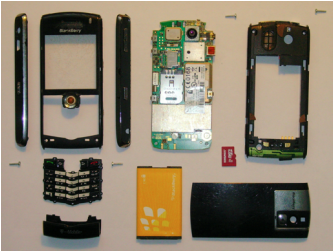|
12/5/2014 0 Comments What’s in my smartphone? By Mary Gallagher If you’re anything like me, you spend a lot of time standing in front of vending machines, counting out pennies in your palm trying to get a bag of Cheez-Its (do I know you or do I know you?). If you’re anything like me, most of the time you probably don’t have quite enough coins to cut it. But never fear! Grab the handy precision screwdriver from your purse and pry open that smartphone. Congratulations – you’ve got $1.58 worth of gold! Enjoy those 90-cent Cheez-Its and get a flip-phone with the money left over. We use gold in smartphones and laptops for its conducting powers. When most people think “conductor” they think copper, but copper, while cheap, is actually way slower at transporting electrons than gold is. Silver is even faster than gold, but it also corrodes much faster, which is no good if you want your phone to last more than a year or so. While insignificant on the level of each individual phone (unless you’re really desperate at that vending machine), extracting precious metals like gold from electronic waste can be both highly profitable and far more environmentally sustainable than traditional gold mining. This has been shown to be successful in small experiments – for instance, over the span of four months in 2010, the Japanese government collected 567,000 used cell phones, which yielded around $784,313.00 in gold, as well as a good amount of silver, copper, and palladium.[1] But much of our e-waste is currently exported to poorer nations in exchange for cash, where cottage economies have sprung up around extracting gold from smartphones and laptops. The incomes earned from inefficient backyard extraction might be too small, however, to balance out the health impacts of the toxic pollution that comes from the e-waste.[2] If countries like the United States follow Japan’s example and recognize the profit in recycling their e-waste, hopefully they will create more sophisticated recycling programs that will both provide jobs and protect the environment and public health from e-waste pollutants. [1]http://books.google.com/books?id=kBDo5ClEaxAC&pg=PA38&lpg=PA38&dq=50+cents+of+gold+in+cell+phones& source=bl&ots=v9zUfaTuU-&sig=xMVj-_8_erVKBuSOqMr1PMQcMws&hl=en&sa=X&ei=- 4lWVKXYOtD4yQTRpYKQBQ&ved=0CDIQ6AEwAg#v=onepage&q= Japanese%20government&f=false [2] http://www.iop.org/news/11/may/page_51103.html
0 Comments
Leave a Reply. |
WELCOME, UMICH SCIENTISTAS!
CAMPUS PICS
WHAT'S NEWUPCOMING EVENTSPAST POSTS
October 2022
SORT BY TAG |
The Scientista Foundation, Inc. All Rights Reserved © 2011-2021 | Based in NY | [email protected]
The Network for Pre-Professional Women in Science and Engineering
The Scientista Foundation is a registered 501(c)(3) -- Donate!
The Network for Pre-Professional Women in Science and Engineering
The Scientista Foundation is a registered 501(c)(3) -- Donate!


 RSS Feed
RSS Feed